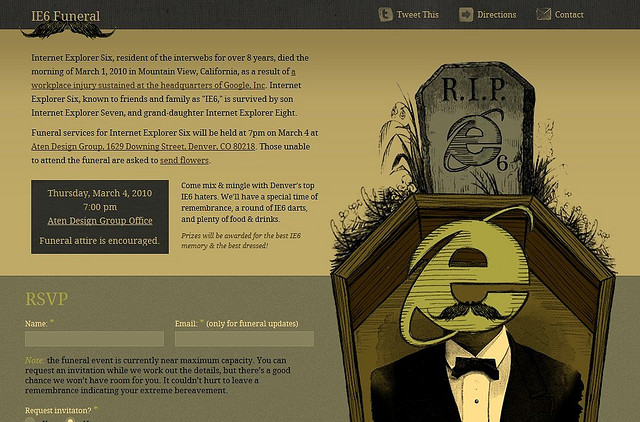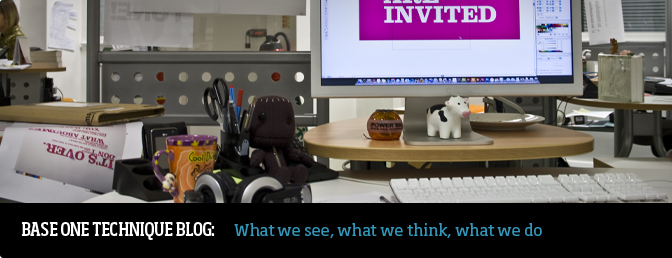The Great Browser Support Problem
 Image from Majento
Image from Majento
As a business, you’re going to want a really nice looking website, right? All the ease of use/navigation and a nice slick interface filled with animation and effects. Of course you do. We all do.
Forget your budget for a second and let’s say you get that site. The creative juices start flowing and the possibilities are almost endless. It’s going to be the best site ever. Finally it’s completed and you couldn’t be happier with the results. It shows just how cutting edge your business is. You might even say a cut above the rest. Excitedly, you go to show your decision-maker what he/she has paid for and-BAM-it looks awful. The formatting is ruined, the effects don’t work and subsequently, you cannot even navigate around.
How can this be? It looked GREAT on your machine. Then the penny drops - they’re viewing in Internet Explorer 6. So are most of your colleagues. So are many of your customers. You go back and have the site amended so it is compatible with IE6. Everything needs to be simplified, possibly even working from the ground up, and suddenly your site looks no better than that of your competitors…
But why is IE6 such a big issue for websites, and what can you do about it?
Here’s some fun IE6 facts* for you:
IE6 came out in 2001 along with Windows XP. Yes, it’s over a decade old.
It was once the leading browser, before Firefox et al appeared.
It does not support modern code, forcing workaround exceptions to be made for IE6, IE7 and, to a degree, IE8.
PNG images that support translucency spawn a rather attractive grey colour instead.
It’s still supported by Microsoft (though to Microsoft’s credit, they are making an effort to get the world off IE6).
It’s a developer’s nightmare.
*facts = some may be on the side of personal opinion.
Before we can discuss creativity, let’s talk about why IE6/7 is still around. To begin with, Windows XP and IE6 were released around the time PCs became affordable, not just to the household, but also to the person. Windows XP is still the most used operating system. In offices, admin rights frequently ‘protect’ PCs, preventing users from installing their own software. This also prevents upgrades to the browser. Then there’s the simple fact most users do not know or care about modern browsers. They simply click on the word ‘Internet’ and the internet appears.
Now you know who your audience is. But that’s not to say they won’t appreciate a cutting edge site when they see it, many of them just don’t know any better. Chrome is the only browser to actively advertise to consumers aside from Internet Explorer, so you could forgive most for not being “browser savvy”.
It’s not just Internet Explorer that’s the issue. We also have the issues of slow machines, mobile and tablet devices that are not necessarily capable of producing the content of a high-end desktop PC.
With this in mind, how is creativity ever to progress in the B2B realm?
1. Leave old browsers behind; keep creativity in the forefront
Many web-designers do this in the B2C world. A little browser detection code will simply tell users, if using an old browser or unsupported platform, that their browser is out of date and simply needs to be upgraded. Unfortunately such sites are aimed at consumers (where there are no upgrade restrictions), not businesses.
2. Have two sites
Many people have optimised sites for mobile. It’s just as possible to create a specific site for older browsers in addition to your creative site. You’re looking at a very expensive solution, though.
3. Do what most others do: keep compatibility in mind
As sad as it is to say, this is often the most cost-effective and safe solution. It’s frustrating for everyone.
Ultimately, you need to think about your audience. If you’re a tech-savvy business with tech-savvy clients, then go crazy and keep the creativity coming because they will probably have the latest browser. If you deal with financial audiences, however, you might just need to wait until the rest of the world catches up with you.
Designers and developers alike have become very good at making the best out of a bad situation, with clever workarounds, but it’s a patchwork solution at best.
Will the world ever catch up? Eventually yes, but whether Microsoft will ever catch up is a different matter…
Internet Explorer 9 was officially released to the public earlier this year, filled with the many ‘modern browser’ features that Chrome/Firefox/Safari users have been enjoying for quite some time. It complies with CSS 3 and HTML5 standards and, for many web designers and developers alike, was welcomed with a sigh of relief. On closer inspection, IE9 might comply with the rules, but it doesn’t necessarily play the prefect’s game, or as a friend on Twitter put it, “IE9: welcome to the party… you’re a bit late though… and it looks like you’ve not brought anything with you…”
Sure, it’s a step forward, but in 10 years’ time, will we be screaming about IE9 preventing creativity?
If Google and Apple get their way, perhaps not. Google have already publically stated that they will no longer officially support IE6, and when you have the most used search engine and video hosting platform, there’s more incentive for IT teams to ensure their staff’s software is kept up-to-date. In Apple’s world, this also isn’t an issue. They’re quicker to phase out compatibility of software (iOS 5, for example will only be compatible with the iPhone 4 onwards), but Microsoft has more responsibility to support legacy software due to a more diverse audience.
In the B2B world, there’s always a need to consider your audience, but there’s absolutely nothing wrong with wanting to push the envelope. As with most things in life, it’s simply a case of finding a balance.





Reply